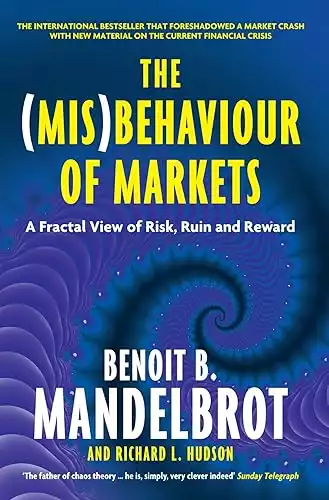Overview : The Misbehavior of Markets
-
Book Title: The Misbehavior of Markets
-
Author: Benoit B. Mandelbrot and Richard L. Hudson
-
Publication Date: October 2004
-
Rating: 4.5
-
price: $17.96
-
Pages: 352
Author Information
"The Misbehavior of Markets" is authored by Benoit B. Mandelbrot, a mathematician renowned for his work on fractals, and Richard L. Hudson, a financial journalist. Mandelbrot challenges conventional financial theories by exploring market volatility and randomness, offering a fresh perspective on understanding financial patterns.
Introduction to The Misbehavior of Markets Book
In the ever-evolving world of finance and investing, few books have challenged the status quo as profoundly as "The Misbehavior of Markets: A Fractal View of Financial Turbulence." Authored by the renowned mathematician Benoit B. Mandelbrot and financial journalist Richard L. Hudson, this groundbreaking work offers a fresh perspective on market dynamics that has the potential to revolutionize our understanding of financial systems.
The Misbehavior of Markets Book Summary
At its core, "The Misbehavior of Markets" presents a compelling argument against traditional financial theories, particularly the Efficient Market Hypothesis (EMH) and the Gaussian distribution of price changes. Mandelbrot, famous for his work on fractal geometry, applies this innovative mathematical concept to financial markets, proposing that they are far more turbulent and unpredictable than conventional models suggest. The authors contend that standard financial models, based on the assumption of rational markets and normal distributions, fail to account for the extreme events that frequently occur in real-world financial scenarios. Instead, they advocate for a fractal approach, which better captures the complex, irregular nature of market behavior.
Analysis of Key Themes
Fractal Geometry in Finance
Mandelbrot's application of fractal geometry to financial markets is the book's central theme. Fractals, geometric shapes that exhibit self-similarity across different scales, provide a more accurate framework for understanding market volatility. This approach acknowledges the inherent complexity of financial systems and offers new insights into market risks and opportunities.
Critique of Gaussian Distribution
A significant portion of the book is dedicated to critiquing the Gaussian distribution, a cornerstone of modern financial theory. Mandelbrot argues that real-world data often exhibit "fat tails," where extreme price changes occur more frequently than predicted by the Gaussian model. This observation suggests that traditional models significantly underestimate market risks.
Risk Management and Investment Strategies
The authors explore the implications of their fractal view for risk management and investing. They argue that a better understanding of market behavior can lead to more effective risk mitigation strategies, encouraging investors and financial professionals to adopt a more cautious and flexible approach to market analysis.
Writing Style
Despite the complexity of the subject matter, Mandelbrot and Hudson have managed to create an accessible and engaging narrative. They skillfully balance technical detail with clear explanations, making the book suitable for both financial professionals and general readers interested in economics and finance.
"The geometry of nature is fractal. The problem is, the geometry of finance in our theories is not." - Benoit B. Mandelbrot
Strengths and Weaknesses of The Misbehavior of Markets
Strengths:
- Innovative approach to financial market analysis
- Challenges established paradigms in finance
- Accessible writing style for complex concepts
- Provides new perspectives on risk management
Weaknesses:
- Some readers may find the dismissal of traditional theories too sweeping
- Practical application of the fractal model in finance remains debatable
- The complexity of the model might hinder its widespread adoption
The Misbehavior of Markets Related Books
"The Misbehavior of Markets" stands out in the field of financial literature for its unique approach. While books like Nassim Nicholas Taleb's "The Black Swan" also challenge traditional financial theories, Mandelbrot's work provides a more mathematical foundation for understanding market unpredictability. Compared to classic works like Burton Malkiel's "A Random Walk Down Wall Street," which aligns more closely with traditional financial theories, Mandelbrot's book offers a radically different perspective on market behavior.
Relevance to Current Market Trends
In today's rapidly changing financial landscape, characterized by the rise of cryptocurrencies and increasing market volatility, Mandelbrot's insights are more relevant than ever. The fractal approach to market analysis could provide valuable insights into the behavior of emerging asset classes and help investors navigate the complexities of modern financial markets.
Highlights from The Misbehavior of Markets Book
Fractal Markets: Financial markets are inherently fractal, exhibiting patterns and turbulence at various scales, challenging traditional models.
Market Complexity: Markets are far more complex and unpredictable than standard finance theories suggest, with frequent outlier events.
Rejection of Gaussian Models: Gaussian (bell curve) assumptions fail to capture market volatility, underestimating extreme changes.
Embrace of Risk: Financial models should incorporate fractal mathematics to better account for risk and sudden shifts.
Persistence of Patterns: Markets exhibit recurring, self-similar patterns, providing a new way to analyze price movements.
New Financial Theory: Mandelbrot advocates a fractal perspective for a deeper understanding of financial behaviors and risks.
Conclusion
"The Misbehavior of Markets: A Fractal View of Financial Turbulence" is a thought-provoking and insightful work that challenges conventional wisdom in finance. While it may not provide all the answers, it certainly asks the right questions, encouraging readers to reconsider their understanding of financial markets and risk. For investors, financial professionals, and anyone interested in the intersection of mathematics and finance, this book is an essential read. It offers both a critique of traditional theories and a visionary alternative that promises to reshape our understanding of markets in the years to come.
If you're intrigued by Mandelbrot's fractal approach to finance and want to explore these concepts further, consider purchasing "The Misbehavior of Markets" through our affiliate link below. By doing so, you'll not only gain access to this groundbreaking work but also support our ongoing efforts to bring you insightful financial analysis and book reviews.
Remember, while this book offers valuable insights, it's essential to consult with financial professionals and conduct thorough research before making any investment decisions. Happy reading and smart investing! In conclusion, this article has provided an overview of the topic at hand.





